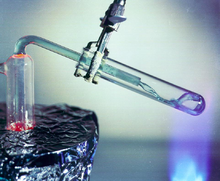- Molten salt
-
Molten salt refers to a salt that is in the liquid phase that is normally a solid at standard temperature and pressure (STP). A salt which is normally liquid at STP is usually called a room temperature ionic liquid, although technically molten salts are a class of ionic liquids.
Contents
Uses
Molten salts have a variety of uses. Molten chloride salt mixtures are commonly used as baths for various alloy heat treatments, such as annealing and martempering of steel. Cyanide and chloride salt mixtures are used for surface modification of alloys such as carburizing and nitrocarburizing of steel. Cryolite (a fluoride salt) is used as a solvent for aluminium oxide in the production of aluminium in the Hall-Héroult process. Fluoride, chloride, and hydroxide salts can be used as solvents in pyroprocessing of nuclear fuel. Molten salts (fluoride, chloride, and nitrate) can also be used as heat transfer fluids as well as for thermal storage. This thermal storage is used in for example solar thermal power plants. [1]
Ambient temperature molten salts
Ambient temperature molten salts are present in the liquid phase at standard conditions for temperature and pressure. The first such salt, an N-ethylpyridinium bromide and aluminium chloride mix, was discovered in 1951.[2]
References
- ^ "Molten Salts systems other applications link to Solar Power Plants". NREL - National Renewable Energy Lab. http://www.nrel.gov/csp/troughnet/pdfs/2007/koning_molten_salt_applications.pdf. Retrieved 2011-09-06.
- ^ Hurley, F. H.; Wier, T. P. J. Electrochem. Soc. 1951, 98, 203.
See also
- Electromagnetic pump
- Molten salt battery
- Molten salt reactor
- Parabolic trough
- Molten salt oxidation
Categories:- Energy storage
- Metallurgical processes
- Inorganic solvents
- Ionic liquids
- Physical chemistry stubs
Wikimedia Foundation. 2010.

